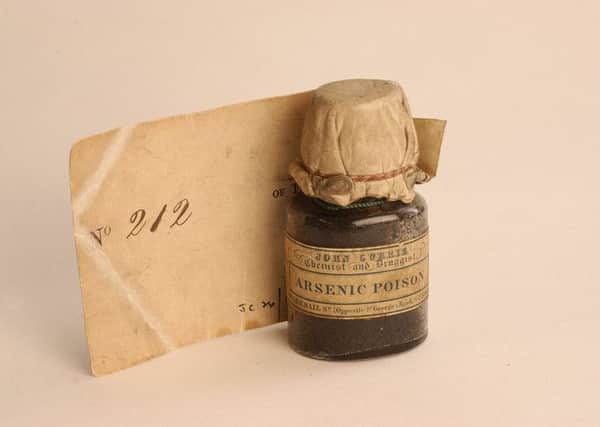Famous Scots from the past highlighted at Edinburgh Fringe


Items frrom Scotland’s history are playing a major part at the Edinburgh Fringe.
An exhibition is showcasing the lives of some of the most famous and infamous Scots, told through treasures from the national archives.
Advertisement
Hide AdAdvertisement
Hide AdOn display in the setting of Robert Adam’s Register House, this is a chance to delve into the collection of historical documents and meet some of the great characters of Scottish history.
Fringe-goers are able to look inside one of the most important buildings in the capital of Scotland.
Poison bottles from an infamous Victorian murder trial, a childhood letter sent by Mary Queen of Scots, documents from the construction of the Forth Bridge, and the Parish Register entry for Robert Burns’ irregular marriage are just some of the items on display at the exhibition by National Records of Scotland.
NRS archivists have gathered a selection of remarkable documents, photographs and artefacts, some of which are on display for the first time, or for the first time together.
They include:
NO BELLS FOR THE BARD
The irregular marriage of Robert Burns and Jean Armour from the 1780s.
Jean Armour was also known as the Belle of Mauchline, after one of Burns’ poems. She was the wife of Scotland most famous poet Robert Burns in the 18th centure and inspired many of his poems. The couple had nine children, but only three survived into adulthood.
CORRESPONDENCE OF A QUEEN
The earliest letter written by a young Mary, Queen of Scots from the 1550s. Mary became Queen of Scotland after the death of her father, King James V in 1542. She also became Queen Consort of France following her marriage to King Francis from 1559-1560, Mary’s complicated personal life, and her religious beliefs, led to her execution by Elizabeth I.
THE MAN WHO BUILT THE BRIDGE
Advertisement
Hide AdAdvertisement
Hide AdPhotographs and documents from the construction of the Forth Bridge. This tells the story of Sir William Arrol’s world-famous project in the 1880s.
Born in Houston, Renfrewshire, Sir William started work in a cotton mill at only nine years of age. He started training as a blacksmith by the age 13. He later joined a company of bridge manufacturers in Glasgow, but then established his own business, the Dalmarnock Iron Works, and went on to help construct the Forth Bridge.
THE TRIAL THAT SCANDALISED SCOTLAND
Poison bottles, love-letters and other productions from the shocking murder trial of Glasgow socialite Madeleine Smith in 1857.
Smith began a secret love affair with Pierre Emile L’Angelier, an apprentice nurseryman from the Channel Islands. Her parents had arranged a marriage and Smith asked for love letters she had written to be returned to her. L’Angelier threatened to use the letters to expose her and force her to marry him, leading to the murder.
Tim Ellis, chief executive at NRS, said there is no better time to look inside one of the most important buildings to grace the capital of Scotland than in the Year of History, Heritage and Archaeology and the 250th anniversary of Edinburgh’s New Town.
He added: “This exhibition is an excellent opportunity to view just part of the wealth of historical materials held by National Records of Scotland, specially selected by our archivists to intrigue both first-time visitors and regular customers”.
Fiona Hyslop, Cabinet Secretary for Culture, Europe and External Affairs, welcomed the new exhibition.
Advertisement
Hide AdAdvertisement
Hide AdShe said: “These items offer us insight into the personal lives of some of the great characters of Scottish history, and each of the Scots featured has something to tell us about Scotland’s story. It’s a fascinating contribution to the Year of History, Heritage and Archaeology”.
